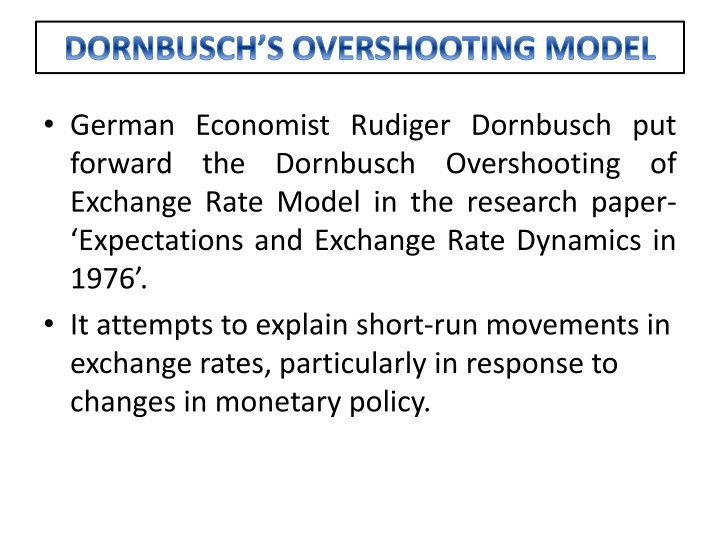
Dornbusch's Overshooting Model in Exchange Rate Dynamics
Learn about Rudiger Dornbusch's seminal Overshooting Model, which explains short-term exchange rate movements due to monetary policy changes. Discover how exchange rates can temporarily deviate from their equilibrium levels before returning, and explore the key assumptions and implications of this model.
Uploaded on | 1 Views
Download Presentation

Please find below an Image/Link to download the presentation.
The content on the website is provided AS IS for your information and personal use only. It may not be sold, licensed, or shared on other websites without obtaining consent from the author. If you encounter any issues during the download, it is possible that the publisher has removed the file from their server.
You are allowed to download the files provided on this website for personal or commercial use, subject to the condition that they are used lawfully. All files are the property of their respective owners.
The content on the website is provided AS IS for your information and personal use only. It may not be sold, licensed, or shared on other websites without obtaining consent from the author.
E N D
Presentation Transcript
DORNBUSCHS OVERSHOOTING MODEL German Economist Rudiger Dornbusch put forward the Dornbusch Exchange Rate Model in the research paper- Expectations and Exchange Rate Dynamics in 1976 . It attempts to explain short-run movements in exchange rates, particularly in response to changes in monetary policy. Overshooting of
The key insight of Dornbusch's Model is the concept of "overshooting(overdepriciates). In response to an economic shock or a change in monetary policy, exchange immediately adjust equilibrium levels. Instead, they "overshoot" or move further away from the equilibrium before gradually returning to it. rates their do not to long-term Dornbusch's model is based on the idea that exchange rates can exhibit short-term volatility and overshoot their long-term equilibrium values before eventually returning to that equilibrium.
When a central bank changes its nominal interest rate, the exchange rate initially moves by more than is required to maintain purchasing power parity (the idea that the same basket of goods should have the same price in different currencies). This overshooting occurs because prices are sticky in the short run, and it takes time for them to adjust. Over time, as prices gradually adjust, the exchange rate moves back toward its long-run equilibrium. This means that in the long run, changes in monetary policy primarily affect inflation rates rather than the nominal exchange rate.
The model is based on the following assumptions- The economy is small as well as open ii. The exchange rate is flexible iii. There is perfect mobility of capital in the economy iv. The demand for money entirely depends on the production output and the interest rate v. Goods prices remain fixed(sticky) in the short run (it means that they do not adjust immediately to changes in supply and demand. This price stickiness leads to an initial mismatch between interest rates and inflation rates in different countries) but keep adjusting slowly in the long run to counter the monetary shocks. vi. The economy is at full employment in the long run. i.
On the basis of above assumptions the model can be explained as follows- Let us assume that the central bank of the country adopts cheap monetary policy for which rate of interest falls. The fall in the rate of interest will increase money supply in the economy. The increase in money supply will increase the aggregate demand and aggregate demand will be higher than the aggregate supply(since according to Keynes aggregate supply can not be increased in short run).
o Since AD> AS there would be Excess Demand in the economy. o Excess demand will further increase price in the economy. o As price increases, supply will increase(due to the application of law of supply) o When producer want to increase supply of goods they will demand more labour. o Since there is full employment, wage will further rise. Rise in wages will increase the cost of production and there will be inflation in the economy which will further enhance the wage rate , cost of production, inflation(wage price spiral). 1.11.2023 prices and
As domestic interest rate fall there will be capital outflow from the economy. It will depreciate value of domestic currency and nominal exchange will rise. In this situation exports (X) will increase and imports (M) will decrease. [AD= C+I+G+(X-M)]. It will shift the IS curve. It is explained with the help of following diagram-
Initially IS0andLM0intersects each other at E0 . As money supply increases LM will shift to LM1, for this rate of interest will fall below the world interest rate. There will be capital outflow for this. For the capital outflow, there will be current account deficit. It will depreciate the domestic currency. As domestic depreciates, exports will rise and imports will fall. It will increase the demand and as a result the IS curve to IS1. IS 1 LM0 LM1 IS 0 E3 E0 E2 currency E1 aggregate
At IS1as aggregate demand is high, price will increase but aggregate supply will not increase for this real balance or the value of money (M/P) will fall. As a result LM will shift back to LM0and new equilibrium will be at E3. IS 1 LM0 LM1 IS 0 E3 In such situation rate of interest will rise which implies that the domestic rate of interest is higher than the world interest rate . It will attract the capital and that there will be surplus in capital account. It will appreciate the value of domestic currency and thus export will rise and import will fall. It will decrease the aggregate demand and thus is will shift back to its initial position IS0and finally the initial equilibrium E0is reached. Thus exchange rate overshoots and finally reach the initial equilibrium position. E0 E2 E1
